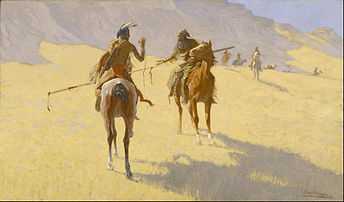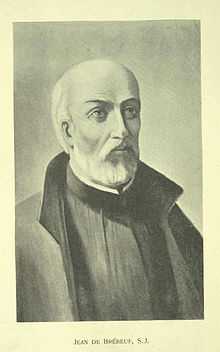How (greeting)

The word "How" or Howgh is a word used as a greeting or particle in the sense of I have spoken in some Native American languages and their popular representations. It is a part of popular depictions of Native Americans in various novels as of James Fenimore Cooper or Karl May and further media.
Background

The Oxford English Dictionary OED uses [haːʊ̯] ("how") for the spelling and claims Jean de Brébeuf had described the use of the term as an interjection of approval with the Wyandot (Hurons). De Brébeuf described individual speakers using Condayauendi Ierhayde cha nonhwicwahachen to signify the end of their section, which was answered by the community with a long "Hooow".[1]
Longman Webster[2] describes Howgh as greeting of the Sioux resepectively "Háu kola" (Hallo friend) as Lakota Sioux greeting. However, it would be the only Lakota term using a Diphthong and is probably of external origin.[3] Dakota and Omaha Sioux use slightly different versions, it might be already an import from Parkmans The Oregontrail as of 1847.[4] The modern actual Indians rhetoric, neither in the case of the Hurons nor the Lakota, wasn't using the term for long, around 1900 "Good Morning" was the preferred greeting.[5]
Usage
Karl May uses Howgh[6] similar to the Schweizerdeutsch closing particle "Ha gschlosse" which is being used to indicate the closure of a votum by the speaker, not the community .[7] In both cases the term expresses a strict Rule of order and a longing for consensus.[7]
Howgh, "Uff!", "Manitu" and Lakota "Hoka Hey" have had major influence on the Popular image of Native Americans in German-speaking countries. Howgh and pale-face gained notoriety through James Fenimore Cooper's Leatherstocking and Francis Parkman's The Oregon Trail. It found its way even in US World War I propaganda stereotypically depicting native American soldiers.
(Wilhelm II) killum papoose und killum squaw, so Jo Fixum will find this Kaiser and stickum bayonet clear through. Ugh!
[8] and Walt Disney's 1953 Peter Pan movie.
Howgh found some applications in German songs depicting native Americans, as in Indianer by Nena (lyrics by Carlo Karges) and Gus Backus Da sprach der alte Häuptling der Indianer (the auld Indian chieftain spoke, covered e.g. by Wildecker Herzbuben and Wirtschaftswunder [9]). It was even part of the social media parodies of German minister of finance Peer Steinbrück's use of Western movie metaphors against Swiss tax policy 2009.[10][11] Raymond Steadman was sort of annoyed about the stereotypical use, which should have ended already within the 19th century and closed with
Reader gettum sick? Have-um enough?
Further reading
- Wolfgang Hochbruck: „I have spoken.“ Die Darstellung und ideologische Funktion indianischer Mündlichkeit in der nordamerikanischen Literatur. Gunter Narr Verlag, Tübingen 1991, ISBN 3-8233-4553-2 (ScriptOralia 32), (Freiburg i. Br., Univ., Diss., 1990).
- Raymond William Stedman: Shadows of the Indian. Stereotypes in American culture. University of Oklahoma Press, Norman OK et al 1982, ISBN 0-8061-1822-9.
- April Renae S. Watchman: Howgh!! I have spoken, uff, uff!: Karl May and 19th century representations of American Indians, Thesis (M.A.)--Arizona State University, 2001, DOI:oclc/49709527
Notes
- ↑ Jean de Brébeuf Jesuit Relation 10, 1636, see Wolfgang Hochbruck "I have spoken" p.36, and J. Axtell, The Indian People of Eastern America, Oxford 1981
- ↑ Longman Webster English college dictionary. Harlow: Longman, 1984
- ↑ Rood, David S., and Taylor, Allan R. (1996). Sketch of Lakhota, a Siouan Language, Part I. Handbook of North American Indians, Band 17 (Languages), p. 440–482.
- ↑ see I have spoken, Hochbruck p.153
- ↑ The Conservative (Nebraska City, Neb.) 18. August 1898, Seite 3, von Laurence Laughlin, The Indians at Omaha,
- ↑ Der Wortschatz Karl Mays, von Joachim Dietze, Georg Olms Verlag Hildesheim, 1999, ISBN 3487105357
- ↑ 7.0 7.1 Handbuch der Phraseologie, Harald Burger, Annelies Häcki Buhofer, Ambros Sialm, Brigit Eriksson, Verlag Walter de Gruyter, 1982, ISBN 3110080028, p. 116
- ↑ American Indians in World War I: at home and at war, Thomas A. Britten, Verlag UNM Press, 1999, ISBN 0826320902
- ↑ Youtube, see 0.51
- ↑ Süddeutsche Zeitung online, 18. 3. 2009, Gerd Zitzelsberger:Nervöse Indianer im Steuerreservat, Steinbrück: Streit mit Schweiz, Im Kampf gegen das Bankgeheimnis verärgert Finanzminister Peer Steinbrück die Schweizer mit „Wildwest-Rhetorik“,
- ↑
- ↑ Steadman p.71, in I have spoken, Wolfgang Hochbruck p. 153